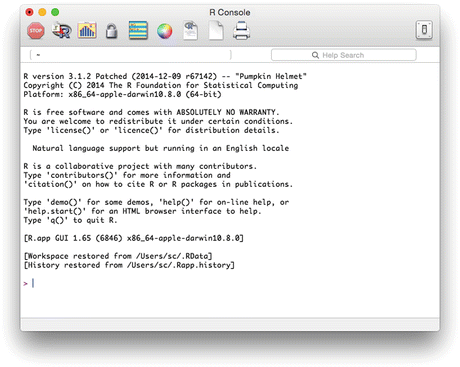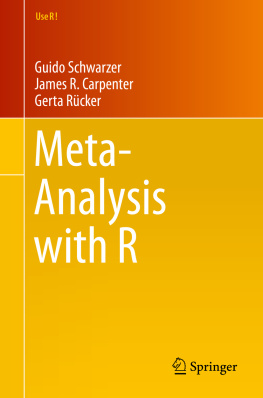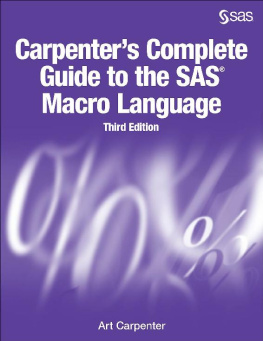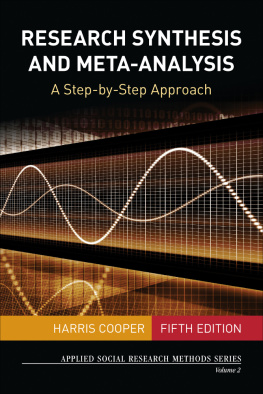1. An Introduction to Meta-Analysis in R
The world is awash with information. For any question, the briefest of internet searches will throw up a range of frequently contradictory answers. This underlies increasing awareness of the value of systematic evidence synthesisboth qualitative and quantitativeby researchers, policy makers and the broader public. It is reflected in the continuing development of the Cochrane Collaboration ( ].
Quantitative aspects have a key role to play in evidence synthesis. The statistical methodology for combining quantitative evidence from studies, known as meta-analysis, therefore features in almost every systematic review, and continues to undergo rapid development. A major concern of such developments is the need to detect and adjust for possible biases, as well as the synthesis of evidence from studies that have compared different combinations of interventions and measured these interventions with different outcomes.
The statistical software environment R [).
We believe that R is a natural choice for meta-analysis, as it provides the greatest range of methodology for meta-analysis in any single statistical software package. Our aim in writing this book is to introduce data analysts involved in meta-analysis, whether they are existing R users or not, to this software. No previous knowledge of R is assumed, and throughout the development is illustrated with worked examples. The data, and script files to repeat the examples, are downloadable from the website http://meta-analysis-with-r.org/ .
Established R users can probably skip the remainder of this chapter, in which we introduce some key R concepts and illustrate them with a simple meta-analysis. The aim in what follows is to get new users (who have used other statistics packages) started with R so that they can follow the presentation in the remainder of the book. For a more comprehensive introduction we recommend [].
The remainder of this chapter is best read alongside a computer running R. Thus, if you have not yet installed R, we would encourage you to do so: full installation details are given in Appendix A.1.
1.1 Getting Started with R
To start R either press on the R desktop icon created during installation or select the corresponding entry in the menu of installed applications. This should open the R Console window, an example of which in Mac OS X is shown in Fig.. R is not a menu driven program, so the user must either type commands at the command line, or execute a pre-written script. R is case sensitive, and most function names are in lower case. Typing the function name shows the code; to execute a function we must type parentheses. For example,
type demo (followed by ), and R will print the code for the demo function,
type demo() (followed by ), and R will open a window showing some of the demonstrations available.
Fig. 1.1
Screenshot of R Console window under Mac OS X
Towards the top of the list is the graphics demonstration. To run this, we need to give the argument graphics to the demo function, by placing it in the parentheses: demo(graphics) . Try this; you will need to press twice more to start the demonstration, and to move through the various plots. In summary: we pass information to R functions through the arguments which go between the parentheses that immediately follow function names.
1.1.1 Quitting R
To exit Rat the command line type q() . You will be asked Save workspace image? [y/n/c]: . Type one of y (yes: quit and save your data); n (no: quit without saving your data) or c (continue with R session), followed by . An alternative way to exit R is using the menu File Exit (under Windows) or R Quit (under Mac OS).
1.1.2 R as a Calculator
To begin, we note the following:
Commands in R are typed into the R Console window to the right of the command prompt : >
If R detects a command is not finished (for example, parentheses or quotes are not matched) then the next line will show the continuation prompt : +
Either complete the command, or interrupt it by typing Ctrl+C under Linux.
The # means that the remainder of the line will not be executed: we use this repeatedly to give a commentary on our R code.
Armed with this, we can start to explore R. In the R Console try the following commands (you do not need to type lines that begin with the # sign):
> # set x to be 2
> x <- 2
> # same assignment
> x = 2
> # display x
> x
[1] 2
> # set x to be the vector 1,2,3 using R function c
> x <- c(1,2,3)
> # same assignment
> x <- 1:3
> # display x
> x
[1] 1 2 3
> # add up the elements of x:
> sum(x)
[1] 6
> # set x to be a matrix
> x <- matrix(c(1,2,3,4), nrow=2)
> # display x
> x
[,1] [,2]
[1,] 1 3
[2,] 2 4
> # square the matrix x
> x*x
[,1] [,2]
[1,] 1 9
[2,] 4 16
> # square x and add 3 to all entries
> x*x + 3
[,1] [,2]
[1,] 4 12
[2,] 7 19
> # create a function, called f, which squares its argument
> f <- function(x){x*x}
> f(2)
[1] 4
> f(c(1,2,3))
[1] 1 4 9
> # square the matrix x using R function f
> f(x)
[,1] [,2]
[1,] 1 9
[2,] 4 16
1.1.3 Getting Help
The easiest way to get help on a function, for example the ls function is to type a ? followed by the function name at the R prompt: ?ls . Equivalently, we can type help(ls) . Either will open a window giving details of how to use the function. For more extensive help, the command help.start() opens a window or tab in your web browser with links to all the documentation.
1.2 Loading, Saving and Restoring Data
Data are stored in R in a slightly different way to many other packages: instead of having a single dataset available at a time, we have instead a workspace (also called global environment or environment) that may be thought of as a virtual library or virtual directory, which can contain many datasets, together with other R objects such as functions. This workspace is stored as a file, with default name .RData under Mac/Linux/Unix and _RData under Windows. Not only can we have separate .RData files for different projects, we can make the contents of as many as we like available to R. This can cause some confusion if they contain different objects of the same name!
For this book, we will only need one .RData file. This we store in the current Working directory . To find the current working directory type getwd() at the R command line.












